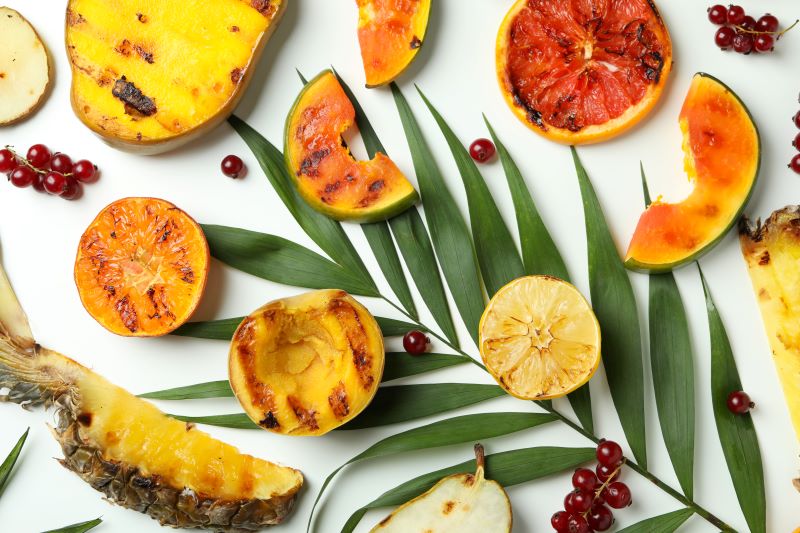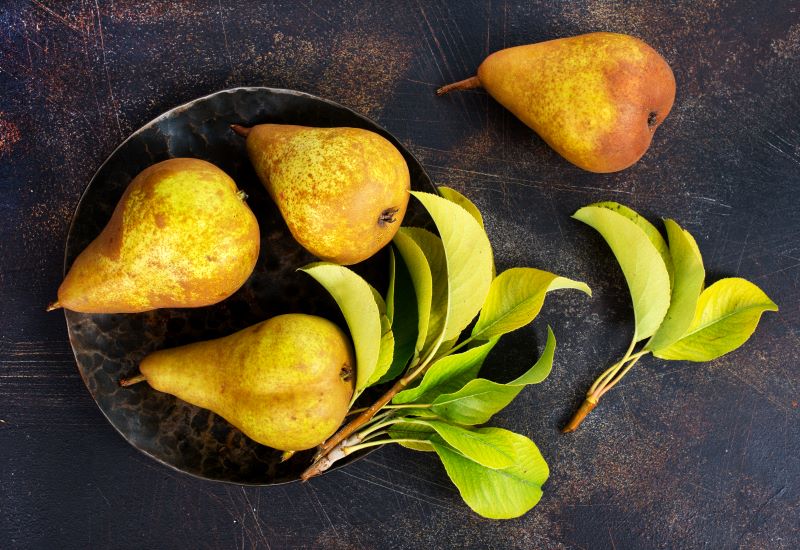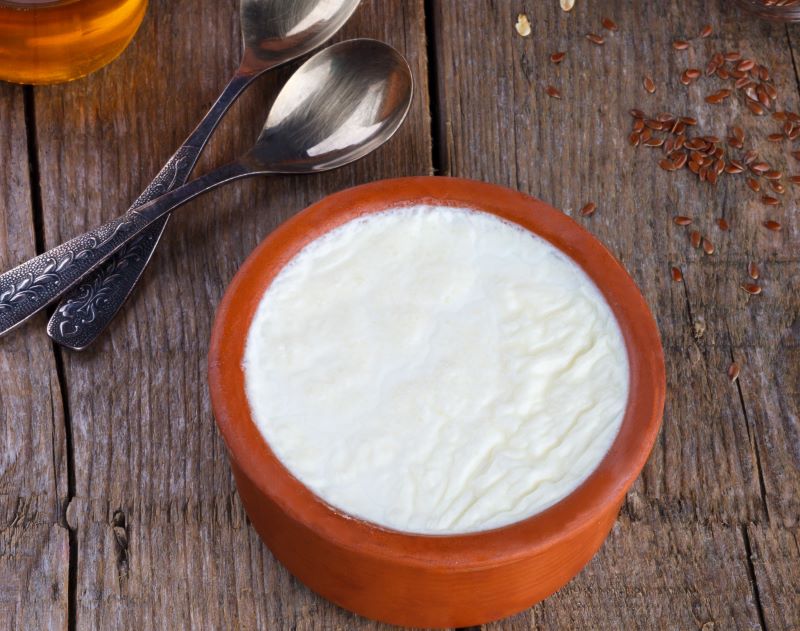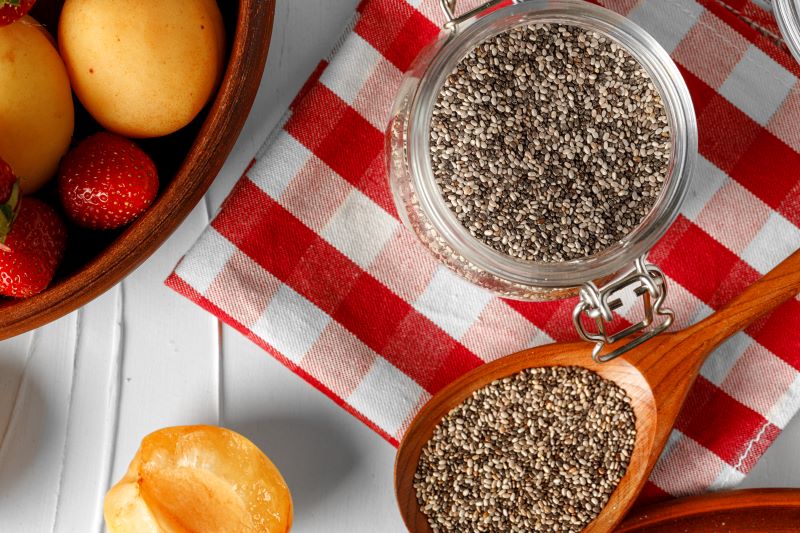43 Fibre-Rich Foods, Fruits & Vegetables to Include in your Diet

Fibres, fruit, and vegetables are a necessary part of your diet. These foods supply the needed nutrients and promote the enzymatic activity of the human digestive system. It is advantageous to implement different fibres since they contain whole grains, legumes, and nuts.
Strawberries, apples, and pears are good examples of such fruits, which are great natural sources of dietary fibre. Green vegetables such as broccoli, carrots, and spinach contribute to dietary fibre intake.
Consumption of such foods regularly helps maintain a good weight and reduces the risk of developing other long-term diseases.

Table of Contents

What is Fibre?
Fibre is a group of carbohydrates found in plants and occurs in nature. It's indigestible. It is not broken down into its parts and absorbed into the body, as are many of the other nutrients during digestion.
Fibre comes in two forms, soluble and insoluble is an essential part of biochemistry. The soluble fibre's ability to absorb water and form a viscous gel-like substance is advantageous for digestion. Stimulating intestinal movement, the soluble fibre in a stool adds heft, thus regulating bowel function.
Adequate fibre intake may assist in digestive health and relieve constipation. Moreover, it was discovered that people who eat diets high in fibre have lower chances of getting heart problems and diabetes.
What are the Sources of Fibre?
Fibre is abundant in various plant-based foods and promotes digestive health. Whole grains like oats, barley, and quinoa are excellent sources of fibre, and legumes like beans, lentils, and chickpeas are rich in dietary fibre.
Fruits like apples, berries, and pears provide soluble and insoluble fibre. Vegetables like broccoli, carrots, and Brussels sprouts are fibre-rich. Nuts and seeds like almonds, chia, and flaxseeds also contain fibre. Including a variety of these fibre-rich foods in your diet supports overall wellness.
Top 43 Food Items High in Fibre
A wide array of foods are rich sources of dietary fibre. These items promote digestive health and aid in weight management. Incorporating them into your diet can help regulate bowel movements and prevent constipation.
Additionally, high-fiber foods promote feelings of fullness and satiety, which can assist in controlling appetite and managing weight. Fruits, vegetables, whole grains, nuts, and seeds are among the top sources of dietary fibre.
The following is a detailed list of 43 foods that are highest in fibre, and you should incorporate this into your diet.
List of Fibre-Rich Vegetables

Fibre-containing vegetables contain a wealth of essential nutrients necessary for human health. The following vegetables will help you achieve the necessary level of fibre intake for improved nutrition and health.
SNo. |
Vegetable | Description |
| 1 | Artichoke | Rich in fibre and antioxidants, artichokes are low in calories and can aid digestion. |
| 2 | Broccoli | Packed with fibre, vitamins, and minerals, broccoli supports digestive health and immune function. |
| 3 | Brussels Sprouts | These mini-cabbages are high in fibre and vitamin C, promoting gut health and immune function. |
| 4 | Carrots | Carrots are not only rich in fibre but also in beta-carotene, supporting eye health and immunity. |
| 5 | Spinach | Spinach is a nutrient powerhouse, offering fibre, vitamins, and minerals for overall health. |
| 6 | Kale | High in fibre and antioxidants, kale is a versatile vegetable that supports heart and bone health. |
| 7 | Sweet Potato | With both soluble and insoluble fibre, sweet potatoes help regulate blood sugar and promote gut health. |
| 8 | Cauliflower | Low in calories and fibre, cauliflower is a versatile vegetable supporting digestion. |
| 9 | Green Peas | Green peas are a good source of fibre and protein, contributing to satiety and digestive health. |
| 10 | Bell Peppers | Bell peppers are rich in fibre and vitamin C, supporting digestive health and immune function. |
| 11 | Eggplant | Eggplants are low in calories and high in fibre, making them a great choice for digestive health. |
List of Fruits Rich in Fibre

Consuming various fruits as part of your diet is an easy and enjoyable way to satisfy the daily requirement for fibre and improve overall health. Here are fibre-rich fruits that will make your meal lively and nutritional.
SNo. |
Fruit | Description |
| 12 | Apples | Crunchy and sweet, apples are rich in soluble fibre, particularly pectin, aiding digestion. |
| 13 | Pears | Juicy and flavourful, pears contain soluble and insoluble fibre, promoting gut health. |
| 14 | Berries (e.g., strawberries, raspberries, blueberries) | Bursting with antioxidants and fibre, berries are excellent for digestion and heart health. |
| 15 | Avocado | Creamy and nutrient-dense, avocados offer both soluble and insoluble fibre for satiety. |
| 16 | Oranges | Refreshing and citrusy, oranges are high in soluble fibre, aiding digestion and heart health. |
| 17 | Bananas | Naturally sweet and portable, bananas contain soluble and insoluble fibre for digestive support. |
| 18 | Kiwi | Tart and tropical kiwis are rich in soluble and insoluble fibre, promoting digestive regularity. |
| 19 | Guava | Fragrant and tropical guavas offer abundant soluble fibre, aiding digestion and blood sugar control. |
| 20 | Figs | Sweet and chewy, figs provide soluble fibre and natural sugars, supporting digestive health. |
| 21 | Prunes | Dense and sweet, prunes are packed with soluble fibre, promoting digestive regularity and gut health. |
List of Cereals and Dairy Products Containing Fibre

Offering our body a full range of vitamins and minerals. The list of cereals and dairy products high in fibre can be a good addition to your diet and make it more nutritious.
SNo. |
Food | Description |
| 22 | Bran Flakes | Crispy whole-grain cereal flakes packed with fibre for a nutritious breakfast option. |
| 23 | Oatmeal | Hearty and satisfying, oatmeal is a classic breakfast choice known for its high fibre content and versatility in toppings. |
| 24 | Whole Grain Bread | Nutrient-dense bread made from whole grains, offering fibre and essential nutrients in each slice. |
| 25 | Yoghurt | A creamy dairy product containing live cultures and a hint of fibre, perfect for a wholesome snack or breakfast addition. |
| 26 | Kefir | Tangy fermented milk drink rich in probiotics and fibre, promoting gut health and digestion. |
List of Seeds and Nuts Rich in Fibre

Nuts are nutrient-dense foods rich in healthy fats, protein, vitamins, and minerals. Despite their nutritional benefits, nuts typically contain varying amounts of fibre:
SNo. |
Seed/Nut | Description |
| 27 | Almonds | Almonds are nutrient-rich nuts packed with protein, healthy fats, and fibre, making them a satisfying and nutritious snack. |
| 28 | Chia Seeds | Chia seeds are tiny powerhouses of nutrition, high in fibre, omega-3 fatty acids, and antioxidants, promoting heart health and aiding digestion. |
| 29 | Flaxseeds | Flaxseeds are a rich source of fibre and omega-3 fatty acids, supporting digestive health and reducing inflammation. |
| 30 | Sunflower Seeds | Sunflower seeds are crunchy snacks packed with fibre, protein, and vitamin E, promoting heart health and providing essential nutrients. |
| 31 | Pumpkin Seeds | Pumpkin seeds are nutrient-dense, rich in fibre, protein, and magnesium, supporting heart health and promoting a healthy immune system. |
| 32 | Sesame Seeds | Sesame seeds are tiny seeds packed with fibre, healthy fats, and minerals, adding a nutty flavour and crunch to dishes while providing essential nutrients. |
| 33 | Hemp Seeds | Hemp seeds are nutritious and high in protein, omega-3 fatty acids, and fibre, supporting heart health and providing essential amino acids. |
| 34 | Pistachios | Pistachios are delicious nuts packed with fibre, protein, and healthy fats, promoting heart health and aiding in weight management. |
| 35 | Walnuts | Walnuts are nutrient-rich nuts high in omega-3 fatty acids, antioxidants, and fibre, supporting brain health and reducing inflammation. |
| 36 | Brazil Nuts | Brazil nuts are creamy nuts rich in selenium, fibre, and healthy fats, promoting heart health and providing essential nutrients. |
List of Animals and Seafood High in Fibre

Additionally, some types of fish, such as salmon and trout, provide fibre. Incorporating these protein-rich options into your diet can increase your daily fibre intake.
SNo. |
Food | Description |
| 37 | Chicken Breast | Lean and protein-rich, chicken breast is low in fibre but high in protein, making it a popular choice for those seeking lean protein. |
| 38 | Turkey Breast | Like chicken breast, turkey breast is lean and protein-packed but contains minimal fibre. |
| 39 | Shrimp | Shrimp is a low-calorie seafood option that provides a modest amount of fibre, protein, and various nutrients. |
| 40 | Salmon | While salmon is a rich omega-3 fatty acids and protein source, it contains negligible fibre. |
| 41 | Tuna | Tuna is another seafood choice prized for its protein content and omega-3 fatty acids, but does not contribute significant fibre. |
| 42 | Beef (Lean Cuts) | Lean cuts of beef provide high-quality protein but are not significant sources of fibre. |
| 43 | Eggs | Eggs are a versatile protein source, but they contain no fibre. |
How Much Fibre Should You Intake Daily?
According to the research, your daily demands for fibre are critical for keeping digestive health in check and for total wellness. Intake of fibre varies with age, gender, and specific health goals. Here is a summary of daily fibre intake guidelines for adults and children to ensure optimal nutrition.
Age Group |
Recommended Fibre Intake (grams per day) |
| 1-3 years | 19 g |
| 4-8 years | 25 g |
| Boys 9-13 years | 31 g |
| Girls 9-13 years | 26 g |
| Boys 14-18 years | 38 g |
| Girls 14-18 years | 26 g |
| Men 19-50 years | 38 g |
| Women 19-50 years | 25 g |
| Men 51 and older | 30 g |
| Women 51 and older | 21 g |
Health Benefits of Including Fibre-Rich Foods in Your Diet
According to the Houston Methodist and other institutes, incorporating fibre-rich foods into your diet offers numerous health benefits.
Through its promotion of digestive health to decrease the chances of developing chronic conditions. Hence, fibre performs an important function in facilitating the body's optimal functioning.
- Improved Digestive Health: Enhanced digestive health leads to better nutrient absorption and overall wellness. Consuming fibre-rich foods aids in regular bowel movements and prevents constipation. Probiotics promote a balanced gut microbiome, supporting digestion and immune function.
- Weight Management: Weight management involves effectively balancing calorie intake, exercise, and lifestyle choices. It requires mindful eating habits, regular physical activity, and sustainable lifestyle changes. Maintaining a healthy weight can reduce the risk of chronic diseases.
- Blood Sugar Control: Fibre-rich foods slow down the absorption of sugar into the bloodstream, preventing spikes in blood sugar levels. They promote a gradual release of glucose, aiding in stable energy levels and reducing the risk of insulin resistance.
- Heart Health: A high-fibre diet can lower the cholesterol level of LDL (the cholesterol that is bad for the heart) and lead to a decreased risk of having a heart disease or stroke. Soluble fibre binds to cholesterol in the digestive system.
- Stabilised Energy Levels: Foods high in fibre deliver energy gradually throughout the day, thus not disrupting energy levels and allowing for a more stable blood sugar throughout the day.
- Improved Skin Health: Fibre-rich foods help regulate blood sugar levels and reduce acne breakouts and skin inflammation. They also promote digestion and detoxification, leading to clearer, healthier skin with improved texture and appearance.
- Reduced Risk of Hemorrhoids: Fibre is crucial in softening the stool and making bowel movements easier. Therefore, the pressure exerted on the rectum is reduced, and the risk of haemorrhoids decreases.
- Enhanced Nutrient Absorption: Optimising nutrient absorption is crucial for overall health and well-being. Pairing nutrients with complementary foods can also improve their bioavailability.
Fibre-rich foods in your diet offer numerous health benefits. They promote digestive health, aid in weight management, and lower the risk of chronic diseases. Including these foods can contribute to overall wellness and longevity.
Different Ways to Include Fibre-Rich Foods in Your Diet
Adding food high in fibre, such as oats, Avocados, beans and berries, most are soluble fibres. Here are five different ways to incorporate fibre-rich foods into your diet. Here are five different ways to incorporate fibre-rich foods into your diet:
- Start Your Day with Whole Grains: Begin your mornings with whole grains for sustained energy levels. They provide essential nutrients like fibre, vitamins, and minerals. Incorporate whole grain options like oats, quinoa, or whole grain bread.
- Load Up on Fruits and Vegetables: Fruits and vegetables offer vital nutrients for overall health and wellness. They're rich in vitamins, minerals, and antioxidants, supporting various bodily functions. Incorporating a variety of colourful produce into your diet promotes vitality.
- Choose Legumes as Protein Sources: Opt for legumes as protein sources for a nutritious diet plan. Legumes are packed with protein, fibre, and essential vitamins and minerals. Incorporating them into your meals can promote satiety and support muscle growth.
- Snack on Fibre-Rich Foods: Use snacks like fibres, which can help satisfy your hunger and permit you to avoid meals between meals. Rather than mindlessly munching on unhealthy snack foods, you might go for whole nuts, seeds, and dried fruits.
- Swap Refined Grains for Whole Grains: You can start by substituting refined grains typical in white bread and other regular pasta with whole grains. Pick wholemeal bread, brown rice, quinoa, and whole wheat pasta to get the fibre content.
What are the Symptoms of Fibre Deficiency?
A lack of fibre can come about in several ways, leading to digestive health problems and other wellness issues. Identifying these symptoms is as important as acting immediately on necessary dietary changes. undefined
What are the Health Risks of Not Getting Enough Fibre?
Low fibre intake threatens potential repercussions on your health, implying a broad range of important areas. Here are the health risks associated with not getting enough fibre:
Constipation leads to discomfort and abdominal pain.
Increased risk of developing haemorrhoids due to straining during bowel movements.
Elevated cholesterol levels raise the risk of heart disease.
Sluggish digestion causes a feeling of fullness and decreased appetite.
Unstable blood sugar levels, potentially leading to diabetes complications.
Higher likelihood of weight gain and obesity due to slower metabolism.
Increased risk of diverticulitis, a painful condition affecting the colon.
Poor gut health contributes to imbalanced microbiota and digestive issues.
Higher risk of colorectal cancer due to prolonged exposure to toxins.
Reduced satiety, leading to overeating and potential nutrient deficiencies.
What are the Side Effects of Excessive Fibre Intake?
Excessive fibre intake can lead to bloating, gas, cramps, diarrhoea, constipation, mineral deficiencies, and intestinal blockages. It may also interfere with nutrient absorption and cause digestive discomfort.
Suppressed immune function that leads to the risk of infections.
Copper deficiency due to interference with copper absorption and metabolism.
Metallic taste or smell in the mouth affects appetite and food enjoyment.
Neurological symptoms include nerve damage, numbness, tingling, and difficulty walking.
Kidney damage or impairment from excessive zinc intake.
Reduced levels of good cholesterol potentially increase the risk of heart disease.
Interference with the absorption of other essential minerals leads to nutrient imbalances.
Should You Take a Fibre Supplement?
This fact calls for assessing a fibre supplement based on the underlying diet and goals. Assess the amount of fibre you currently consume from whole foods (such as fruits, vegetables, and whole grain products) in your diet.
A dietary fibre intake deficiency occurs when the foods one consumes contain very limited amounts of fibre or are fibre-free altogether. At this point, fibre supplements can be helpful.
As a person gets more fibre, they can improve digestion, prevent irregular bowel movements, and relieve constipation. Indeed, it is one of the measures that may be used to manage blood sugar and lower cholesterol levels. Rather, strive for whole foods wherever possible as a healthier option.
Additives should only be used with a balanced diet and should not be a complete substitute for it—separate side effects such as bloating and an increase in gas. Consult a healthcare provider before you begin any new supplement intake program.
Fibre-rich foods play a crucial role in maintaining digestive health and regularity. They aid in preventing constipation and promoting a feeling of fullness. Including them in your diet supports overall well-being and balanced nutrition.
What is Fibre?
Fibre is a group of carbohydrates found in plants and occurs in nature. It's indigestible. It is not broken down into its parts and absorbed into the body, as are many of the other nutrients during digestion.
Fibre comes in two forms, soluble and insoluble is an essential part of biochemistry. The soluble fibre's ability to absorb water and form a viscous gel-like substance is advantageous for digestion. Stimulating intestinal movement, the soluble fibre in a stool adds heft, thus regulating bowel function.
Adequate fibre intake may assist in digestive health and relieve constipation. Moreover, it was discovered that people who eat diets high in fibre have lower chances of getting heart problems and diabetes.






